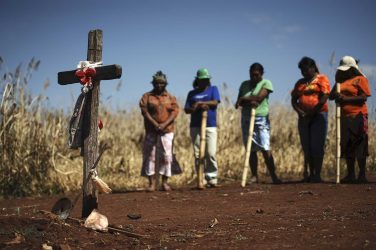The prison population throughout Latin America has been growing steadily for the past few decades. Harsh drug laws and anti-gang policies have led to a massive increase of the number of people incarcerated, leading to overcrowding in underfunded and often neglected penitentiary systems.
The majority of prisoners have yet to be tried, and may wait for years for a hearing. In some countries, gangs continue to operate and recruit new members from inside prisons, and gang leaders order extortion and homicides from behind bars.
This phenomenon can be clearly seen in Brazil, which has recently attained the unfortunate distinction of having the world’s fourth highest rate of incarceration.
In the last fifteen years, the country’s incarceration rate grew by 7 percent annually, ten times faster than its population growth. Over the past 25 years, Brazil’s prison population rose from 90,000 to almost 600,000. It is projected to rise to 1.9 million by 2030 if current rates persist.
This massive rise is associated with two interrelated trends of the past decade: first, the expanding use of pre-trial detention, most frequently associated with the second trend – drug possession arrests, despite a 2006 change in the criminal code that decriminalized the possession of small amounts of marijuana for personal use.
A 2014 study by the Center for Studies in Criminology and Citizenship (Centro de Estudos de Segurança e Cidadania, CESeC) notes that 40 percent of Brazil’s incarcerated population is awaiting trial. The figure for Rio de Janeiro alone is 39 percent, or 11,000 people. In the northeast states of Piauí and Maranhão, these rates reach 60 percent.
Consistent with prison trends in the United States, the majority of incarcerated individuals in Brazil are young males aged 18 to 29. Of these, 61.6 percent are Afro-descendent. Of the rising prison population in Brazil, the fastest growing segment is of women, a phenomenon consistent with similar trends in most Latin American countries.
From 2005 to 2014 the rate increased 10.7 percent annually, from 12,925 to 33,793 during the nine-year period. Drug trafficking was the reason for guilty sentences in 64 percent of women’s incarceration.
Like so many constitutional provisions and laws on the books in Brazil, a statute passed in 2011 (Lei das Medidas Cautelares), just the most recent of several alternative sentencing statutes for non-violent crimes, is rarely applied.
A 2011 study in Rio showed that pre-trial detention is still determined in 73.3 percent of cases while paying bail, electronic monitoring, and other alternatives to prison before trial are ignored by the great majority of judges.
Unable to Meet Demand
The vast majority of those arrested are unable to pay for private attorneys, leaving them dependent on a precarious and understaffed public defender system.[1] Though mandated by the 1988 Constitution, the establishment of public defender offices at the state level has been slow to take hold.
The most recent state offices were established only in the period from 2011 to 2013. Demand far outstrips the capacity of the system. By the Justice Ministry’s own 2009 statistics, demand increased by 45 percent from 2006 to 2008, while the number of public defenders grew only by 4.5 percent.
There are also highly significant imbalances in terms of quantity and quality of public defender services based on geography. In Rio, 90 percent of criminal defense cases are handled by public defenders, while 72 percent of counties in the rest of the country lack any public defender services.
A constitutional amendment approved in 2014 mandated that every county in Brazil must have a public defender agency within eight years.
Dominance of Criminal Factions
With current high arrest rates, reluctance to apply alternative sentencing solutions, the severe shortage of public defenders, and estimates of the prison population reaching almost 2 million in the next 14 years, the over-crowding of the country’s 1,424 prisons – leading to inhumane treatment, torture, and riots – creates a fertile terrain for the growth and dominance of criminal factions. These groups are able to virtually rule prisons as a parallel power to the official corrections structure.
In Rio, prisons have been dominated by rival factions for decades. The original criminal organization in Rio, the Red Command (Comando Vermelho, CV) and its current rival Friends of Friends (Amigos dos Amigos, ADA) now have branches in most prisons in the country, as does the First Capital Command (Primeiro Comando da Capital, PCC) from São Paulo.
The PCC was created after the massacre of 111 prisoners by the São Paulo Military Police in 1992 at the Carandiru Prison. Rebellions due to over-crowding and inhumane conditions have been frequent throughout the country and have resulted in torture, beheadings, and assassinations.[2]
In most states, the PCC and the CV have maintained a 20-year tenuous alliance that has facilitated gun and drug purchases and minimized inter-gang prison violence.
However, that alliance now seems to have come to an end following the PCC attacks against the CV in prisons in the northern states of Roraima and Rondônia on October 16 and 17, which left 18 prisoners dead. Prison experts expect increased violence between the two groups throughout the country.[3]
“Solutions”
No group in the criminal justice community doubts the statistics, the projections of prison population growth, or the reality of human rights abuses. Yet ways of dealing addressing the dilemma vary widely depending on who is proposing the solution.
1) Privatization of Prisons: Whether the model includes outsourcing the prison administration and/or services or creating public-private partnerships, the privatization model is increasingly attractive to a number of state governments.
Contrary to the trend in the United States and Europe to eliminate prison privatization, seven Brazilian states now have a total of twenty-two privatized prisons.
Seen by its proponents as a more humane and economically efficient means of incarceration, private prisons offer cleaner conditions, better health and education services, and “employment opportunities,” meaning cheap labor for manufacturing facilities inside the prisons.
While the Constitution states that no worker should earn less than the minimum wage, prison workers earn less, do not receive benefits, and generally cost 54 percent less than a non-incarcerated worker.
Prisoners are selected for private prisons on the basis of positive prior behavior and lack of connections with criminal factions in order to avoid faction-generated violence.
Critics, such as the NGO Juízes para a Democracia, see these prisons as unconstitutional, noting that the private sector is not concerned with rehabilitation but with profit.
The slogan of a recently inaugurated prison in metropolitan Belo Horizonte is “Less cost and greater efficiency.” As in all privatized prison complexes, the greater the number of prisoners, the greater the return on investment.[4]
2) Custody Hearings (Audiências de Custódia): In an effort to reduce the prison population and those held in pre-trial detention, in 2011 the Brazilian Senate passed a provisional law requiring that a suspect be brought before a judge within 24 hours of his or her arrest to determine the legality of the arrest and the advisability of pre-trial detention or of alternative to prison.
The hearings are also held to determine whether the arrest involved torture or mistreatment by the arresting officer. Brazil is one of the few Latin American countries that has not adopted audiências de custódia as determined by the San José Pact, to which Brazil is a signatory.
An evaluation of the first pilot project to carry out audiências de custódia coordinated by the Instituto de Defesa do Direitos de Defesa (IDDD) with the participation of researchers and NGOs from eight other states concluded that there the hearings resulted in only a slight reduction in the numbers of suspects sent to pre-trial detention.
Moreover, the awkward conditions under which the hearings were held, such as in the presence of the arresting police officer, allowed for little confidence that there would not be retaliation for denunciations of mistreatment or violence.
Nevertheless, evaluators concluded that the hearings, if carried out properly, would be an important step to reducing human rights violations of the criminal justice system.[5]
Prospects for Reform
In the post-impeachment government of President Michel Temer, there is no assurance that the limited progress made in increasing access to justice within the criminal justice system (including public defenders and audiências de custódia) will continue.
Recently, an appeals court judge in São Paulo annulled the guilty sentences of several Military Police officials who had been convicted in the 1992 Carandiru Prison massacre, arguing that the officers had acted in legitimate self-defense.
Likewise, Justice Minister Alexandre de Moraes has taken a clear “law and order” stance, prioritizing the fight against organized crime and securing borders as a strategy to reduce homicides instead of the more multi-faceted approach proposed by a network of researchers and public safety professionals in the prior government.
The Minister has claimed that more research and diagnostics are not needed. Instead, resources will be applied to purchasing equipment.
In response to the prison riots of Roraima and Rondônia, Moraes minimized the conflict stating that the rupture was “merely boasting,” a position that ignores the grave reality of faction generated prison violence and human rights abuses.
The personnel of the National Secretariat for Public Safety within the Justice Ministry has experienced a total turn around, including the hiring of military personnel, which has not been seen since the 1990s.
And with the push to privatize a number of public services, further prison privatization will most likely be encouraged. It now falls to civil society organizations to increase pressure to ensure that the limited progress made in the past decade will not be reversed.
Notes:
[1] “Mapa da Defensoria Pública no Brasil,” Instituto de Pesquisa Econômica Aplicada, 2013, http://www.ipea.gov.br/sites/mapadefensoria. Fania Rodrigues, “Porta para a Justiça: Defensorias públicas são opção de justiça para pobres, mas sofrem com defiências estruturais,” in O Judiciário no Banco dos Réus, Caros Amigos, 2014, http://www.carosamigos.com.br/index.php/edicoes-tematicas/1621-edicao-especial-judiciario.
[2] There is by now a significant literature on organized crime and its impact on prisons, especially with regard to São Paulo and Rio. Two, in particular, are useful: Sérgio Adorno and Camila Nunes Dias, “Cronologia dos ‘Ataques de 2006′ e a nova configuração de poder nas prisões na última década,” Revista Brasileira de Segurança Pública, 2016, http://revista.forumseguranca.org.br/index.php/rbsp/article/viewFile/698/242; and Benjamin Lessing, Making peace in Drug Wars: Crackdowns and Cartels in Latin America, forthcoming.
[3] Martha Alves, Sidney Gonçalves do Carmo, and Camila Dall’Agnol, “Rebeliões deixam ao menos 18 mortos em presídios no Norte,” Folha de São Paulo, October 17, 2016, http://www1.folha.uol.com.br/cotidiano/2016/10/1823433-briga-de-faccoes-deixa-12-mortos-em-presidio-de-roraima.shtml. See also Benjamin Lessing, “Negotiating with Brazil’s Prison Gangs: Short-term Fix, long-term Problem,” InSight Crime, September 15, 2014, http://www.insightcrime.org/news-analysis/negotiating-brazil-prison-gangs-short-term-fix.
[4] Paula Sacchetta, “Quanto mais presos, maior o lucro,” Publica, May 27, 2014, http://apublica.org/2014/05/quanto-mais-presos-maior-o-lucro. Juízes para a Democracia, “Nota técnica contra o PLS #513’2011: pela não privatização do sistema carcerário.” February 15, 2015, http://www.ajd.org.br/documentos_ver.php?idConteudo=199.
[5] Instituto de Defesa do Direito de Defesa, http://www.iddd.org.br. See also “Pesquisa analisa impactos de audiências de custódia,” Centro de Estudos de Segurança e Cidadania, October 9 2016 http://www.ucamcesec.com.br/2016/10/09/pesquisa-analisa-impactos-de-audiencias_de_custodia_no_rio/; Maria Teresa Cruz, “Violência policial é ignorada em mais de 45% das audiências de custódia,” Ponte, http://ponte.org/violencia-policial-e-ignorada-em-mais-de-45-das-audiencias-de-custodia/.
This article was originally published by the Washington Office on Latin America (WOLA) – https://www.wola.org/













